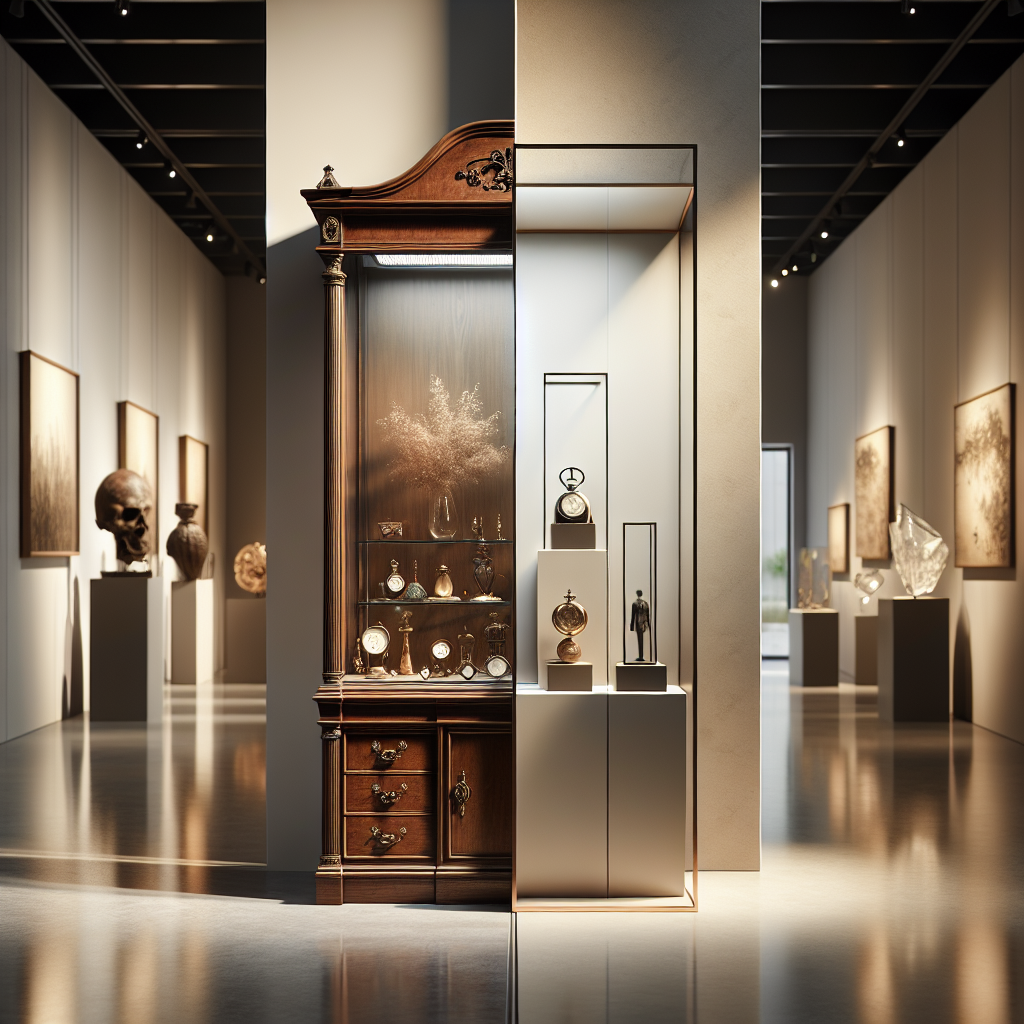A Look Back of Display Cabinets Over Time
A Look Back of Display Cabinets Over Time


Display cabinets have served a dual purpose as both practical storage units and pivotal pieces of decorative furniture. Originating from glazed panelled cupboard designs of the 18th century, they transformed into independent furniture pieces as it became fashionable to display fine objects and decorative china during the 19th century. But the journey of display cabinets from then to the contemporary choices we see today is filled with fascinating transformations influenced by cultural, artistic, and societal changes. In this blog, we delve into how this elegantly functional piece of furniture, the display cabinet, has morphed over centuries. We'll take you through its early origins – inspired by Ancient Greek and Egyptian influences, its evolution over various eras, and its place in our homes today.
The Early Origins of Display Cabinets
The original display cabinets evolved from bookcases of the 18th Century. Georgian examples, often constructed with figured walnut veneer, marked early prototypes of display cabinets seen today. As the collection and showcasing of decorative objects and fine china turned into a fashionable trend during the 19th century, these glazed panelled cupboards transformed into independent furniture pieces, thus birthing traditional display cabinets.
Ancient Greek Influence
Ancient Greeks left an indelible mark on the art of furniture design. Aiding in the evolution of the conventional cabinet, their legacy is the advent of curved features in furniture. The addition of curvy lines provided a refreshing contrast to the otherwise square or rectangular designs often admired in furnishing. This design enhancement brought new life to table legs and chair backs, making furniture pieces, including display cabinets, more aesthetically appealing. The beauty of their invention persists in contemporary furniture, epitomising the Greeks' timeless artistic contribution. They initiated a transformative shift in furniture aesthetics, paving the way for style improvements over generations.
Egyptian Furniture and Display Cabinets
Similarly, Ancient Egyptian influence plays a significant role in the origins of early display cabinets. With their penchant for artistic and practical designs, Egyptians created display cabinets that combined functionality with ornate aesthetics. Utilising locally available resources like wood, stone, and even animal bones, Egyptian craftsmen assembled intricate cabinets to display jewellery, antique relics, and other valuables. Their design ethos involved turning mundane objects into extraordinary masterpieces - an approach visible in the elaborate designs found on the wooden structures. As such, Egyptian furniture laid the foundation for exquisite craftsmanship, which was firmly etched within the evolution of display cabinets.
Evolution of Display Cabinet Designs
As societies evolved, so did the design sensibilities of display cabinets. The journey from practical bookcases to ornamental cabinets underwent significant transformations during various historical eras - Victorian, Edwardian, and the Arts and Crafts Movement. Each period added distinct decorative elements influenced by societal values and aesthetic preferences.
Victorian Display Cabinets
The Victorian era saw display cabinets crafted with more ornamentation and made from exotic woods such as mahogany or oak. Cabinets from this period were not just functional furniture pieces but also mirrored backdrops for decorative objects.
Characteristics of Victorian Display Cabinets:
● Constructed using Figured Woods like Burr Walnut and Maple
● Decorative elements such as barley twist frames lining the doors and inlaid detailing introduced
● Mirrored backs to better reflect the decorative objects and enhance the room's lighting
● Adjustable, fabric-lined shelves, perfect for displaying books, collectables or artefacts
These qualities, coupled with the craftsmanship involved in their creation, make Victorian display cabinets a cherished antique piece in any household.
Edwardian Display Cabinets
Moving on to the Edwardian period, carving played a vital role in the modification of display cabinets. The favourite material for making these was walnut, and the decoration and designs often borrowed attributes from notable sources like Chippendale and Hepplewhite. This showcase for collectables was striking because of its glazing bars and the bow-fronted glazed panels. It stood on tapering spade feet, and a brazen gallery further augmented its beauty. The exotic timbers inlaid with fine boxwood string inlays showcased the craftsmanship of the Edwardian period, transforming these cabinets into treasured pieces of elegant furniture.
Arts and Crafts Movement
The Arts and Crafts Movement in the late 19th and early 20th centuries brought profound change and simplicity to the design of display cabinets. This period marked a stark contrast to the ornate aesthetic of earlier times and focused instead on a return to simplicity, functionality, and handcrafted uniqueness.
● Practical yet Elegant: Cabinets incorporated simpler lines and less extravagant decoration without compromising elegance.
● Handcrafted: Artisans highlighted the beauty of natural materials with hand-finished details.
● Functional approach: Cabinets maintained their functionality while showcasing a visually clean aesthetic.
● Material choice: Designers picked sturdy woods, such as oak and walnut, to create durable, timeless pieces.
These principles led to the creation of cabinets that were not only beautiful but also embodied the philosophy of the Arts and Crafts Movement.
Connection Between Display Cabinets and Antique Furniture
Display cabinets bear a strong connection with antique furniture, both functionally and stylistically. They are contributions from different periods, each representing an evolution in design and artistry. Their shared lineage traces back to centuries-old customs where furniture had aesthetic and socio-economic connotations apart from serving a practical purpose. Evidently, the improvisations and transformations of display cabinets have been in tandem with those of antique furniture.
Reflection of Societal Values in Display Cabinets
Display cabinets illustrate more than furnishings. Each era, design, and detail subtly reflect the societal values of the period. From the utilitarian Early Origins to the ornate Victorian and Edwardian designs and simplicity of the Arts and Crafts Movement, each transformation signified societal shifts. The changes in cabinet design mirrored the gradual evolution in style and growing sophistication of society's aesthetic sensibilities.
Modern Adaptations of Classic Display Cabinets
Today, display cabinets continue to be a focal point in modern homes, manifesting an admirable blend of traditional craft with contemporary style elements. Living room display cabinets now venture beyond traditional wood, embracing materials such as metal, acrylic, and glass. Contemporary designs, while paying homage to their rich history, embody an aesthetic that aligns with modern-day styling and practical demands.
Contemporary Display Cabinets for Living Spaces
In contemporary designs, display cabinets have adapted to serve multiple purposes and styles while continuing to offer functionality. Modern-day cabinets exhibit a clean-lined aesthetic and minimalist design. Display cabinets are not just about displaying your possessions anymore. They serve a broader role of complementing the interior décor, serving storage needs, and even acting as room dividers in open layouts. Given their versatility, these cabinets find usage in living rooms, dining areas, study rooms, or even kitchens. They are available in many designs and shapes - freestanding, wall-mounted, large, small, or narrow, meeting the diverse requirements of modern homes. These cabinets also incorporate LED lighting and adjustable shelving options, offering enhanced visual appeal and flexibility.
Curio Cabinets in Modern Architectural Designs
There is a particular type that deserves special mention in the world of modern-day display cabinets - the curio cabinet. Presenting a perfect blend of art and functionality, curio cabinets are an apt choice for showcasing collectables and treasures. Whether you want to display family heirlooms, vintage collections, or cherished memorabilia, they make these objects the focal point. With built-in lighting and mirrored backs, curio cabinets give a spotlight to your collectables, making them a true standout. The use of materials like glass, metal, or acrylic gives them a fresh, contemporary look. These cabinets can seamlessly integrate with different architectural styles, whether traditional or modern, contributing to an appealing aesthetic mix.
Use Cases of Display Cabinets Across Time
Display cabinet uses have varied across different periods, reflecting the shifting norms and lifestyles of society. From showcasing valuable ornaments, fine china, and precious books in the bygone era, they have extended their roles to displaying collectables, meeting household purposes, and commercial presentations in contemporary times. The evolution of their design parallels the changing usage requirements over time.
Showcasing Collectibles
● Display Special Collections: Whether you are an antique aficionado, a coin collector, or someone who cherishes miniature models, a display cabinet offers a worthy stand for your prized possessions.
● Protecting Heirlooms: Delicate heirlooms and pieces of personal history find a secure and elegant space within these cabinets. The lockable cabinets provide an added safety measure.
● Enhancing Visual Appeal: With the right lighting and arrangement, collectables can transform from mere objects into visual treats, adding an extra touch of charm to your space.
Household Dining and Storage Needs
Historically, display cabinets had a significant role in dining areas, showcasing fine china and delicate glassware. Modern cabinets continue to meet these needs while offering additional storage options. They can house dinnerware, wine bottles, and even cooking books, keeping them organised and readily accessible. Whether in the kitchen or the dining area, these cabinets provide a blend of practicality and aesthetics.
Business and Commercial Presentations
In the commercial world, display cabinets serve as an effective tool for product presentation. Whether in a retail store, restaurant, or museum, they showcase items attractively and securely.
Importance of Display Cabinets in Business:
● Window Dressing: Offers visually engaging, enticing product displays, attracting potential customers
● Space Utilisation: Maximises floor space by displaying products vertically
● Product Protection: Helps keep the valuables safe and dust-free
Thus, display cabinets can be valuable assets, promoting sales and enhancing customer experience.
The journey of the display cabinet from an 18th-century panelled bookcase to a significant piece of decorative furniture today is fascinating. It is evident that distinct historical eras - Ancient Greece, Victorian, Edwardian, and Arts and Crafts Movement - have enriched it with their unique influences. The display cabinet serves more than just a functional purpose; it symbolises changing societal aesthetics and values.
Today, it seamlessly blends with modern interiors, proving its enduring charm and relevance.
While styles and designs evolved and usage expanded, the essence of the display cabinet remains consistent - a celebration of craftsmanship and aesthetic appeal. Whether reflecting exotic woods in the Victorian era or narrating contemporary lifestyle narratives, the rich history and wide-ranging functionality make display cabinets a noteworthy constituent of furniture design and our living spaces.
